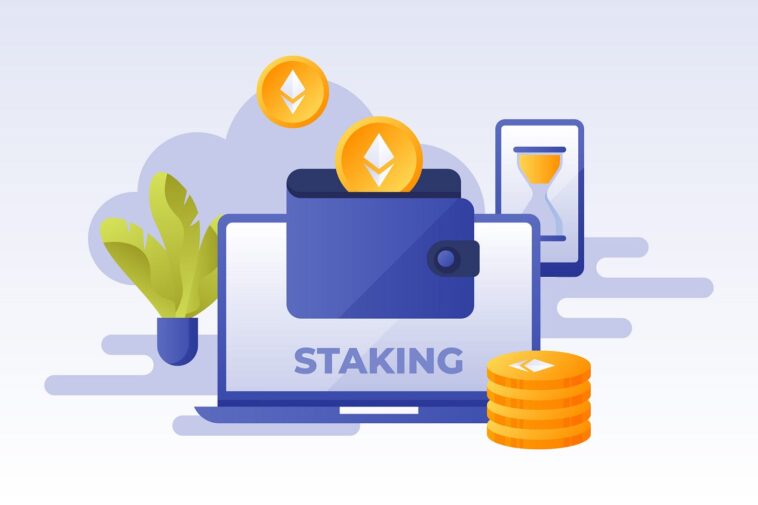Cryptocurrency is slowly becoming mainstream among people worldwide. Even though not every person chooses to start mining, more people are becoming interested in investing in cryptocurrency.
However, virtual currencies have more use cases apart from investing opportunities. For example, people can start staking cryptos to earn passive income in digital currencies. In this article, you will learn more about staked crypto and how to start staking crypto.
Understanding Crypto Staking

So, what is staking crypto? Let’s start with the basics. The very first blockchain, Bitcoin, operates according to a consensus mechanism called Proof of Work (or PoW). It’s a process when the blockchain user validates a transaction by solving a complex algorithm – it’s best known under the term “mining.”
PoW requires a lot of computing power to compete against other miners for a reward. As a result, the competition became so high that miners started using as much energy as a small country used within a year! Mining has become a problem since it started harming the environment. Moreover, miners had to invest in mining rigs to contribute enough computing power to get crypto rewards.
That’s how crypto staking became a “thing.” Crypto staking works according to the Proof of Stake consensus mechanism. That’s why validating transactions isn’t called mining but crypto staking.
The process requires holding and validating transactions on a blockchain network in exchange for rewards. Instead of using mining rigs, users buy a cryptocurrency and “lock” it in stakes. The bigger the stake, the better your chances of validating a transaction and receiving nice rewards. Moreover, crypto staking doesn’t require users to buy expensive mining rigs and use electricity to mine crypto.
Instead, users have a chance to earn passive income. This process is similar to making a deposit in a bank and earning income on interest rates.
How To Stake Crypto?

Now that you understand the meaning of staking crypto let’s learn how to start staking. Here’s a standard guide with steps to follow:
- Choose cryptocurrency. As mentioned, some crypto is built on top of blockchains that operate according to Proof of Work, and others operate according to Proof of Stake. Thus, you must choose a crypto built on the PoS blockchain. Some popular and best staking cryptos include Ethereum (the blockchain recently switched from PoW to PoS), Cardano, Polkadot, Tezos, and Solana.
- Create a crypto wallet. You must choose and set up a cryptocurrency wallet that supports staking for your chosen cryptocurrency. Some crypto wallets have in-built staking features for you to start staking crypto. However, most crypto wallets help you store crypto and transfer it to a blockchain to start staking.
- Buy the chosen crypto coin or token. You must first acquire the cryptocurrency that you plan to stake. You may get it via a centralized cryptocurrency exchange or a decentralized peer-to-peer exchange. The latter option implies that you already have another cryptocurrency type to buy the one you want to stake. For instance, you have BTC to buy SOL to stake it.
- Move your cryptocurrency from an exchange wallet to a staking wallet. After purchasing your cryptocurrency, you must transfer it to your staking wallet. Make sure you follow the wallet provider’s instructions.
- Select a staking pool or validator. If you don’t have enough cryptocurrency to stake on your own, you may join a staking pool or delegate your tokens to a validator. As you know, bigger crypto stakes have better chances of validating a node and, thus, obtaining a crypto reward. You will earn a percentage of the staking benefits if the staking pool or validator handles the technical aspects of staking on your behalf.
- Begin staking. You may begin staking crypto tokens when you’ve set up your wallet and selected a staking pool or validator. The number of coins you stake and the cryptocurrency’s staking mechanism will determine your staking benefits. Simply put, the bigger the stake, the higher the percentage of rewards you receive in crypto.
Some platforms even have crypto staking calculators showing how much you should earn in a specific period. It is critical to understand that staking has risks, and you should only stake bitcoin that you can afford to lose. Before staking your chosen cryptocurrency, you should also conduct your own study. Never invest in cryptocurrency based on someone’s assumption that it’s the next best thing since sliced bread. If they say so, and you believe them, still do the research.
Learn why this specific cryptocurrency is safe and will gradually increase in value throughout the years. If there are no logical grounds to make this claim, don’t invest in this cryptocurrency.
Monitor the Staking Process

Monitoring the staking process is an essential part of staking cryptocurrency as it ensures that the staking rewards are earned efficiently and without interruption. There are several aspects to consider when monitoring the staking process:
- Rewards earned: Keep track of the staking rewards earned, as they are the main benefit of staking cryptocurrency. Check that the rewards are being credited to the staking wallet as expected.
- Staking process status: Monitor the status of the staking process regularly. Check that the staking wallet is online and connected to the network, and that the staked amount is being used for staking.
- Staking performance: Analyze the staking performance to ensure that the staked amount is generating a reasonable return. If the staking returns are lower than expected, consider adjusting the staking settings.
- Security: Keep the staking wallet secure by regularly updating the wallet software and using strong passwords. Also, be aware of any potential security threats and take necessary precautions.
By monitoring the staking process, stakers can ensure that they are earning rewards efficiently and securely.




